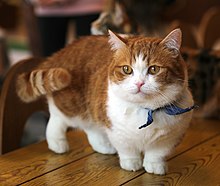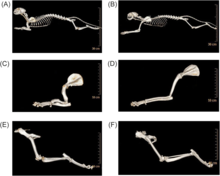Dwarf cat


A dwarf cat (sometimes nicknamed a sausage cat[1]) is a domestic cat with dwarfism due to rare genetic mutations that cause a disproportionate feline body. The mutation usually leads to significant health problems. Unlike undersized cats of normal proportions, dwarf cats suffer from the genetic mutations osteochondrodysplasia and achondroplasia (a form of osteochondrodysplasia). These genetic disorders of bone and cartilage are typically manifested as abnormal bone shape, poor growth or lack of growth, bowing of the limbs to the side – front legs are more likely to be affected, and spinal malformations.
The breeding of dwarf cats is prohibited in several countries and states, due to the animal’s welfare concerns. Furthermore, except for TICA, all major cat registries do not recognize nor allow the crossbreeding with dwarf cats.
Characteristics
[edit]
The dwarf cat is recognized by its characteristically short legs, they are chondrodysplastic and have much shorter and thicker legs than the average cat. Because of their health problems and abnormal bone growth, these cats typically lead a shorter life of 12–15 years.[2] Dwarf cats often suffer from spinal disorders, such as lordosis (excessive curvature of the spine) and pectus excavatum (hollowed chest).[3] In regards to behavior, dwarf cats may be no different from the average cat. They can be playful, curious, and fast.
Cats with dwarfism have become significantly popular, but breeding dwarf cats has been viewed as unethical due to the lifelong health results. Dwarf cats became famous worldwide due to the social media spread by famous internet cats with dwarfism, such as Grumpy Cat and Lil Bub.
The term "dwarf cat" is incorrectly applied to cats such as Toy and Teacup Persians which, though small, are breeds of normal feline proportions.[4]
Breeds
[edit]
The Munchkin cat is breed of cat characterized by its short legs. The Munchkin is the original breed of dwarf cats. The International Cat Association (TICA) gave recognition to the Munchkin as a breed in 1994.[5] Minuet cats are longhaired dwarf cats, and the name is often used interchangeably with the Napoleon. The Minuet is a cross between the Persian and the Munchkin. The Munchkin is approximately three inches shorter than the average cat.[6] The deformities can lie anywhere in the front legs, affecting the humerus, radius and ulna, and the back legs, affecting the femur, tibia and fibula.[7]
The Munchkin has grown significantly in popularity, but due to ethical concerns, the breed has been banned from registration in show registries, and is therefore primarily bred in the US.[7] Other proposed breeds like the Skookum and Bambino have not been given recognition, although a Sphynx–Munchkin hybrid, the Minskin, is under study.[8] Four other breeds include the Lambkin and the Kinkalow, the Genetta and the Scottish Kilt.
List of dwarf cat breeds
[edit]- Munchkin
- Napoleon or Minuet (Persian x Munchkin)
- Skookum (LaPerm x Munchkin)
- Bambino (Sphynx x Munchkin)[9]
- Minskin (Sphynx x Munchkin)[9]
- Lambkin (Dwarf) (Selkirk Rex x Munchkin)[9]
- Kinkalow (American curl x Munchkin)[9]
- Genetta (Bengal x Munchkin)
- Scottish Kilt (Scottish Fold x Munchkin)
Breeding ethics and ban
[edit]Cat fancy
[edit]Other than TICA, all major cat registries and pet associations do not recognize any dwarf cat as a legitimate breed. The animals are excluded from most major pet shows and contests. Largely an American phenomenon, they are not widely accepted outside of the United States.
In its registration rules, the Fédération Internationale Féline prohibits breeds based on dwarfism, and specifically mentions the Munchkin as an example of unacceptable manipulation of "genetic disease".[10]
Breeding ban
[edit]In order to protect the animal’s welfare, several countries and states have prohibited breeding of dwarf cats, including the Netherlands (2014),[7][11] and Victoria (Australia).[12] The Australian Capital Territory (Australia) government consider the Munchkin breed to be "malformed animals" and the deliberate breeding of them "unacceptable" because of the "genetic health problems associated with such breeding".[13]
They are effectively banned under the European Convention for the Protection of Pet Animals and have been strongly condemned in the British magazine Cat World. In the US itself, the ASPCA admonishes its supporters to "stay vigilant" against the small but spreading market.[14]
Genetics
[edit]
To determine if a cat has feline dwarfism, X-rays, bone samples, and genetic testing can be done.[15] Genetic testing on cats with feline dwarfism is being utilized in human research as well.
Felis Catus 9.0, a reference genome for the cat, was utilized in research to analyze DNA of cats using genome sequencing, genetic linkage, origin of the parents, and genome-wide association studies.[16] Each of these approaches yielded the result of the dwarfism phenotype resting within the area of the B1 chromosome in the cat. An unidentified novel gene was also discovered that controls disproportionate dwarfism. The test requires a sample of blood or a buccal swab to provide the DNA. Different cats are compared to determine if the dwarfism is proportionate or disproportionate. Cats with disproportionate dwarfism are more common and aside from leg deformities, the cat is not known to have many more health problems.
Testing
[edit]There are many tests that can be run on cats: feline immunodeficiency virus (FIV) and feline leukemia virus (FeLV) tests, heartworm tests, fecal tests, blood tests, etc. Depending on the problems a cat is exhibiting, or what concerns the pet owners may have, different, more advanced tests may be ordered. If a cat is showing signs of feline dwarfism, specific testing can be done to determine if dwarfism is the cause, or if another condition, such as congenital feline hypothyroidism, is causing symptoms similar to feline dwarfism.
Congenital feline hypothyroidism
[edit]Dwarfism has the potential to be mistaken as congenital feline hypothyroidism. Signs such as disproportionate dwarfism, skeletal abnormalities, and mental disabilities point to both dwarfism and hypothyroidism. Because of this, proper testing can determine whether the cat is showing signs of hypothyroidism or if there is a deeper issue.[17]
A blood test measures the levels of thyroid-stimulating hormone (TSH) in the cat can be performed to rule out feline dwarfism. The test checks the levels of the thyroid hormones thyroxine (T4) and triiodothyronine (T3) and will determine if the cat has hypothyroidism, or if further testing needs to be done to come to a different diagnosis.[18]
In 2018, a study was performed on a 10-month-old kitten showing signs of disproportionate dwarfism. Testing was performed on the (TSH), which confirmed hypothyroidism in the kitten.[19] The kitten was prescribed thyroid hormone supplementation and after 22 months, presented as an average, healthy cat. Once diagnosed, thyroid hormone supplementation should start as early as possible.
See also
[edit]References
[edit]- ^ "Vets warn trend for sausage cats is cruel". Metro UK. January 31, 2017. Retrieved April 14, 2020.
- ^ Braaksma, Hilary; Guthrie Updated, Claudia (April 25, 2021). "Munchkin". Daily Paws. Retrieved 2022-11-26.
- ^ Wedderburn, Pete (October 2008). "Cat breeds–Trophies with hidden problems". Journal of Small Animal Practice. 49 (10): i–xxviii. doi:10.1111/j.1748-5827.2008.00680.x – via BSAVA Companion.
- ^ "DWARF, MIDGET AND MINIATURE CATS (TEACUP CATS)". Retrieved 30 October 2014.
- ^ "Munchkin breed introduction". Tica.org. TICA, Inc. 2013. Archived from the original on 13 December 2013. Retrieved 12 December 2013.
- ^ Braaksma, Hilary; Guthrie Updated, Claudia (April 25, 2021). "Munchkin". Daily Paws. Retrieved 2022-11-22.
- ^ a b c Netherlands Food and Consumer Product Safety Authority (NVWA) (2022-10-31). "Fokken met katten - Honden en katten". www.nvwa.nl (in Dutch). Retrieved 2023-04-01.
- ^ "Minskin breed introduction". Tica.org. TICA, Inc. 2013. Archived from the original on 13 December 2013. Retrieved 12 December 2013.
- ^ a b c d The cat encyclopedia: the definitive visual guide. First American edition. Miezan Van Zyl, Inc DK Publishing. London. 2014. ISBN 978-1-4654-1959-0. OCLC 859882932.
{{cite book}}: CS1 maint: location missing publisher (link) CS1 maint: others (link) - ^ Breeding and Registration Rules: 2.7.3 Genetic Diseases. Fédération Internationale Feline
- ^ Netherlands Food and Consumer Product Safety Authority (NVWA) (2022-10-31). "Fokken met katten met schadelijke kenmerken of erfelijke ziektes - Nieuwsbericht - NVWA". www.nvwa.nl (in Dutch). Retrieved 2023-04-01.
- ^ Department of Jobs, Precincts and Regions (2020-07-06). "Code of Practice for the Breeding of Animals with Heritable Defects that Cause Disease - Agriculture". Agriculture Victoria. Retrieved 2023-04-01.
- ^ Australian Capital Territory, Code of Practice for the Welfare of Cats in the ACT
- ^ "Cat History". Aspca.org. ASPCA. 2013. Retrieved 13 December 2013.
- ^ Taylor, Jessica (2021-08-24). "Dwarfism In Cats: What You Need To Know". All About Cats. Retrieved 2022-11-26.
- ^ Lyons, L.A.; Fox, D.B.; Chesney, K.L.; Britt, L.G.; Buckley, R.M.; Coates, J.R.; Gandolfi, B.; Grahn, R.A.; Hamilton, M.J.; Middleton, J.R.; Sellers, S.T.; Villani, N.A.; Pfleuger, S. (2019-07-08). "Localization of a feline autosomal dominant dwarfism locus: a novel model of chondrodysplasia". doi:10.1101/687210. S2CID 199638613.
{{cite journal}}: Cite journal requires|journal=(help) - ^ Bojanić, K; Acke, E; Jones, BR (2011-05-01). "Congenital hypothyroidism of dogs and cats: A review". New Zealand Veterinary Journal. 59 (3): 115–122. doi:10.1080/00480169.2011.567964. ISSN 0048-0169. PMID 21541884. S2CID 46452306.
- ^ Grauer, Gregory F; Schermerhorn, Thomas; Armbrust, Laura; Vaske, Heather (August 2014). "Diagnosis and management of feline hyperthyroidism: current perspectives". Veterinary Medicine: Research and Reports. 5: 85–96. doi:10.2147/VMRR.S39985. ISSN 2230-2034. PMC 7337209. PMID 32670849.
- ^ Jacobson, Teresa; Rochette, Judy (September 2018). "Congenital Feline Hypothyroidism With Partially Erupted Adult Dentition in a 10-Month-Old Male Neutered Domestic Shorthair Cat: A Case Report". Journal of Veterinary Dentistry. 35 (3): 178–186. doi:10.1177/0898756418785946. ISSN 0898-7564. PMID 30168381. S2CID 52134920.